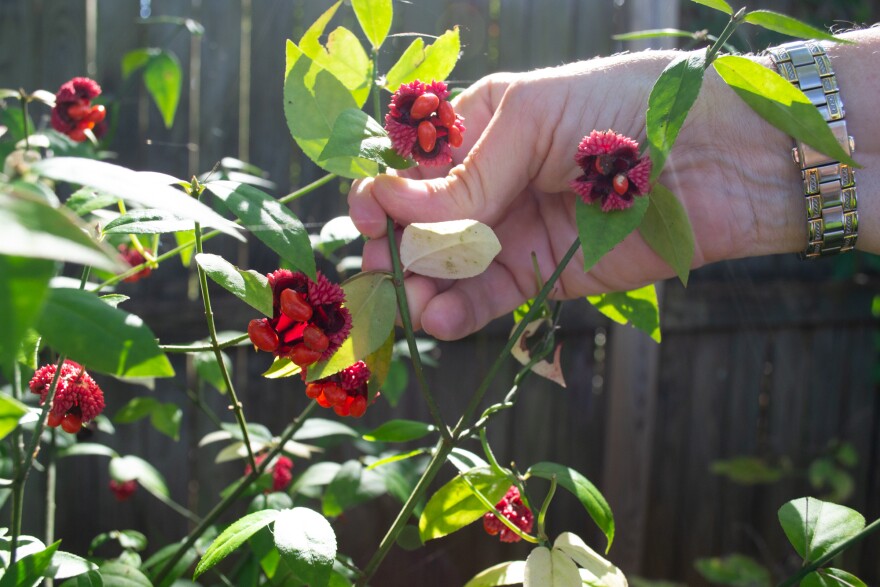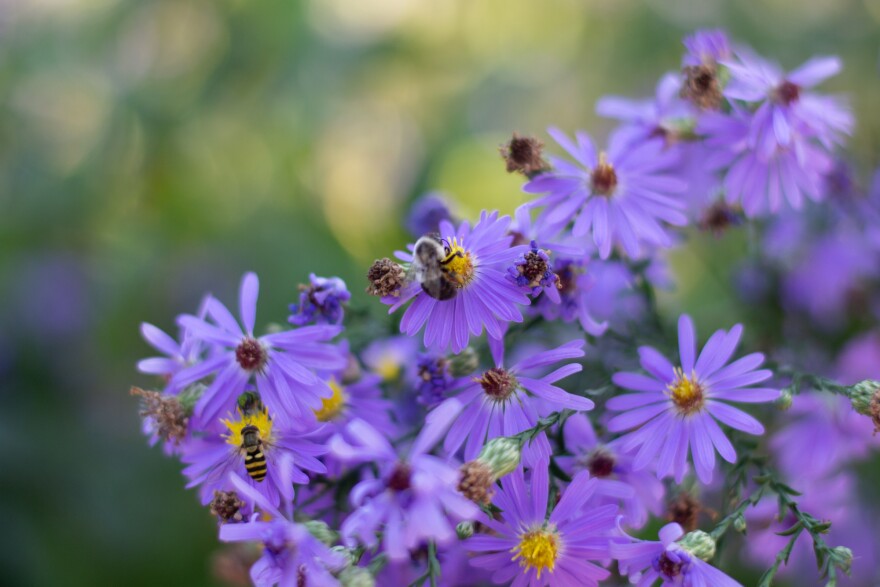One local homeowner has joined the native plants movement. She’s cultivating a wildlife oasis in her backyard. WMRA's Randi B. Hagi reports.
Behind a wooden privacy fence on the outskirts of Charlottesville, birdsong and the buzz of insects beckon you to a secret garden. Narrow mulched paths wind through a shoulder-high tapestry of grasses and goldenrods, phlox and fleabane flowers that grow underneath American holly and Eastern redbuds.
All of these species are native to this part of Virginia, and the garden is Mary's labor of love. (Mary values her privacy, so we agreed to withhold her last name.) Since 2018, she's been converting her backyard from a third of an acre of mud into a thriving microcosm of the natural Piedmont ecosystem.
MARY: These are the grasses that are so lovely. … [grasses rustling] There are several different kinds – there's 300 kinds of plants back here! … [footsteps] And then this is your normal kind of violet, and the violets are actually habitat for the fritillary butterfly.
I was thrilled when Mary invited me to come do a story on her garden, since I just hopped on the native plants bandwagon with my own little yard this spring.

MARY: I've been gradually phasing out the European things that were here, like there was a lilac not doing very well anyway, so we dug it out and put in a native fringe tree.
She hired the Center for Urban Habitats to design the landscape and provide labor and expertise. The native plants movement centers on creating the kinds of habitats that existed here before European colonization and the introduction of invasive species. The goal is a little ecosystem where native species can thrive – especially those in decline due to human activity, like monarch butterflies.
There's an oft-cited statistic in this crowd from entomologist and wildlife ecologist Doug Tallamy, that a nesting chickadee needs to bring home 350 caterpillars per day to feed its young. So the native plants feed the bugs and wildlife, the insects feed the birds and pollinate the plants, the wildlife spread seeds, the plants stabilize the topsoil and filter the air and rainwater – so on and so forth.

For example, black-eyed susans, drying in the fragrant autumn sun –
MARY: These seed heads? The goldfinches will munch on all winter long. … [footsteps] And that daisy fleabane seems to come up in a different place every year, depending on, literally, where the wind blows.
Besides the ecological benefits, this also creates a beautiful, relaxing place to be.
MARY: [bird calls] This is my little mental health corner, where I can watch the pollinators and listen to the birds, and also see butterflies in the summer. … Tiger swallowtail, I've seen the hummingbird moth, the zebra swallowtail, which is really special.
Mary won a grant from the Thomas Jefferson Soil and Water Conservation District for a portion of the project. Meghan Sobbott, residential programs coordinator, explained that the funds come from the Virginia Conservation Assistance Program, or VCAP, which aims to –
MEGHAN SOBBOTT: … encourage homeowners to install stormwater management best practices that will help provide nutrient and sediment reductions into our local waterways, and we're offering cost shares to help financially incentivize homeowners to install these best management practices.
Their conservation district covers Charlottesville and the counties of Albemarle, Fluvanna, Louisa, and Nelson. Eligible projects include –
SOBBOTT: Conservation landscaping practices, which would include meadows, tree plantings, or mulched beds. In addition, they can also install rain gardens, permeable pavers, dry wells, and impervious surface removal practices, as well as a few others.
The funding available depends on the type of project you're doing, so check out their website for a full list. Other conservation districts throughout the state offer VCAP grants as well.

MARY: I think it does take some effort to find the right people to help you with your natives. … Get started with whatever small way you can. Plant a patch of milkweed! You can have just a very small patch and you can do something to help the pollinators.
Mary said the first few years were challenging, before the native plants got more established and started out-competing the invasives. There's still some upkeep, but more often now she gets to sit back and appreciate her patch of wilderness.
MARY: So, when the mockingbird really gets singing, it's quite exciting to hear … and so there's mockingbirds nesting there, nesting in the hummingbird bush, and I think nesting in that tree, too.
HAGI: And you said you also have nuthatches?
MARY: Yeah, nuthatches nest in that fairy hole, bluebirds have nested in these boxes – the bluebirds can make multiple broods a year! … And also the chickadees, northern flicker. I've seen both kinds of woodpecker back here, goldfinches, cardinals, blue jays, a hawk. I even saw the red-shouldered hawk standing right on top of my little Saint Francis statue's head!
Yes, that's a little Saint Francis of Assisi watching over everything from a stump.
MARY: Well, Saint Francis loved the animals, and you know, called them brother and sister. … I had to do something to decorate that stump. You know, they're habitat for fungi and insects! So we leave the snag, and then the woodpecker goes for the insects in there, and … it's just nice to have something besides monoculture lawn. It's just not everybody's aesthetic!
If you'd like to learn more, the Virginia Native Plant Society and its local chapters have great resources.



